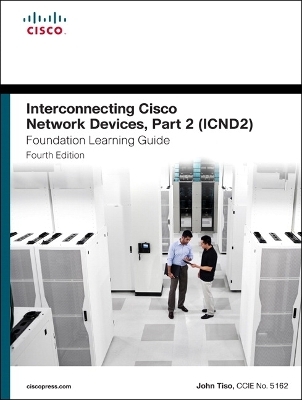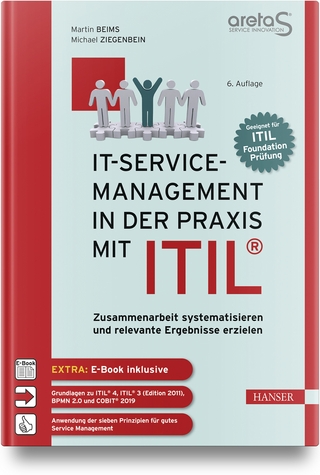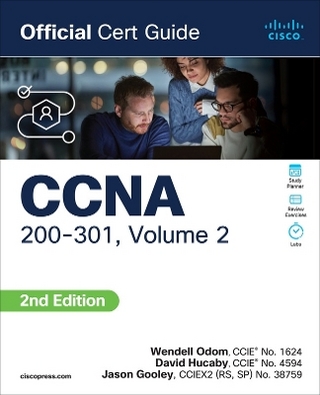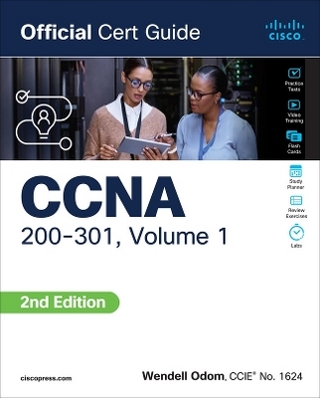
Interconnecting Cisco Network Devices, Part 2 (ICND2) Foundation Learning Guide
Cisco Press (Verlag)
978-1-58714-377-9 (ISBN)
This book teaches with numerous examples, illustrations, and real-world scenarios, helping you rapidly gain both expertise and confidence. Its coverage ranges from internetworking essentials to advanced diagnostic and debugging techniques that are needed by virtually all Cisco professionals.
The book teaches you the technology and theory for building and troubleshooting medium to large scale internetworks, including an in-depth study of VLANs as well as redundancy technologies such as HSRP, STP, and EtherChannel. Additional topics include: implementing scalable mid-sized networks; troubleshooting basic connectivity; implementing EIGRP solutions and OSPF-based scalable multiarea networks; understanding WAN technologies; managing network devices; and advanced troubleshooting.
This edition has been fully updated to reflect Cisco’s latest exam blueprints. Content has been reorganized, simplified, and expanded to help you learn even more efficiently. The book presents you with information applicable to the CCNA that can’t be found in any other CCNA text, including an overview and primer of MPLS, real-world examples, and real-world information on how to more effectively work with the Cisco TAC and diagnose software defects. The book also shows you how to use the Cisco ‘Debug’ command to learn how protocols work.
Interconnecting Cisco Network Devices, Part 2 (ICND2) Foundation Learning Guide, Fourth Edition is part of a recommended learning path from Cisco that includes simulation and hands-on training from authorized Cisco Learning Partners and self-study products from Cisco Press. To find out more about instructor-led training, e-learning, and hands-on instruction from authorized Cisco Learning Partners worldwide, please visit www.cisco.com/go/authorizedtraining.
VLANs, Spanning Tree Protocol (STP), Hot Standby Routing Protocol (HSRP), and EtherChannel
Troubleshooting basic connectivity in IPv4, IPv6, and virtualized network environments
EIGRP theory, operation, and troubleshooting (IPv4 and IPv6)
OSPF terminology, operation, configuration, and troubleshooting (IPv4 and IPv6)
WAN technologies, terminology, theory, configuration, and troubleshooting
VPNs and WANs: comparisons and integration
Device management with SNMP, SYSLOG, and Cisco Flexible NetFlow
Cisco Integrated Service Routers: architecture, configuration management, Cisco IOS software images, and licensing
Advanced diagnostics, Cisco IOS software bugs, and debugging
John Tiso , CCIE #5162, holds a variety of industry certifications in addition to his Cisco CCIE. These include the Cisco CCDP, Cisco CCNP-Voice, Cisco CCT, and several specializations from Cisco. He is a Microsoft MCSE and also holds certifications from CompTIA, Nortel Networks, Novell, Sun Microsystems, IBM, and HP. John has a Graduate Citation in Strategic Management from Harvard University and a B.S. degree from Adelphi University. His writing has been published in a variety of industry journals and by Cisco Press. He has served as a technical editor for McGraw-Hill and Cisco Press. John is a past Esteemed Speaker for Cisco Networkers (Live!) and was a speaker at the National CIPTUG Conference. He has been an expert on Cisco’s “Ask the Expert” NetPro forum and a question developer for the CCIE program. John’s current role is as a senior engineer at a Cisco Partner. He has a quarter of a centuryexperience in the technology industry, after deciding to stop carrying refrigerators in the family business. Prior to his current position, he held multiple roles while working at Cisco, including TAC Engineer, Systems Engineer, and Product Manager. While at Cisco,one of John’s last projects was as a member of the team that developed the recent updates to the CCNA program. Prior to joining Cisco, he was a lead architect and consultant for a Cisco Gold Partner. John currently resides in Amherst, New Hampshire, with his wife Lauren and their three children, Kati, Nick, and Danny. John is a nine-time marathon finisher and also a Therapy Dog International certified handler of his therapy dog and running partner, Molly. He can be reached at johnt@jtiso.com .
Introduction xviii
Chapter 1 Implementing Scalable Medium-Sized Networks 1
Understanding and Troubleshooting VLANs and VLAN Trunking 2
VLAN Overview 2
Trunk Operation 6
Configuring Trunks 7
Dynamic Trunking Protocol 8
VLAN Troubleshooting 9
Trunk Troubleshooting 10
Building Redundant Switch Topologies 11
Understanding Redundant Topologies 12
BPDU Breakdown 15
STP Types Defined 20
Per-VLAN Spanning Tree Plus 21
Analyzing and Reviewing STP Topology and Operation 24
Examining Spanning-Tree Failures 26
STP Features: PortFast, BPDU Guard, Root Guard, UplinkFast, and BackboneFast 28
Improving Redundancy and Increasing Bandwidth with EtherChannel 29
EtherChannel Protocols 31
Port Aggregation Protocol 31
Link Aggregation Control Protocol 32
Configuring EtherChannel 33
Checking EtherChannel Operation 34
Understanding Default Gateway Redundancy 36
Hot Standby Router Protocol 37
HSRP Interface Tracking 38
HSRP Load Balancing 39
HSRP in Service Deployments 39
HSRP in IPv6 40
Gateway Load-Balancing Protocol 40
Chapter Summary 42
Review Questions 42
Chapter 2 Troubleshooting Basic Connectivity 47
Troubleshooting IPv4 Basic Connectivity 48
Components of End-to-End IPv4 Troubleshooting 48
Verification of Connectivity 51
Cisco Discovery Protocol 58
Verification of Physical Connectivity Issues 60
Identification of Current and Desired Path 63
Default Gateway Issues 66
Name Resolution Issues 68
ACL Issues 71
Understanding Networking in Virtualized Computing Environments 72
Troubleshooting IPv6 Network Connectivity 75
Understanding IPv6 Addressing 75
IPv6 Unicast Addresses 76
Components of Troubleshooting End-to-End IPv6 Connectivity 78
Verification of End-to-End IPv6 Connectivity 79
Neighbor Discovery in IPv6 80
Identification of Current and Desired IPv6 Path 82
Default Gateway Issues in IPv6 82
Name Resolution Issues in IPv6 83
ACL Issues in IPv6 84
IPv6 in a Virtual Environment 86
A Last Note on Troubleshooting 86
Chapter Summary 88
Review Questions 88
Chapter 3 Implementing an EIGRP Solution 91
Dynamic Routing Review 92
Routing 92
Routing Domains 92
Classification of Routing Protocols 93
Classful Routing Versus Classless Routing 94
Administrative Distance 95
EIGRP Features and Function 98
EIGRP Packet Types 100
EIGRP Path Selection 101
Understanding the EIGRP Metric 103
EIGRP Basic Configuration 105
Verification of EIGRP Configuration and Operation 106
EIGRP Passive Interfaces 108
Load Balancing with EIGRP 111
Variance 112
Traffic Sharing 113
EIGRP Authentication 114
Troubleshooting EIGRP 115
Components of Troubleshooting EIGRP 115
Troubleshooting EIGRP Neighbor Issues 118
Troubleshooting EIGRP Routing Table Issues 121
Issues Caused by Unadvertised Routes 121
Issues Caused by Route Filtering 122
Issues Caused by Automatic Network Summarization 123
Implementing EIGRP for IPv6 124
EIGRP IPv6 Theory of Operation 124
EIGRP IPv6 Feasible Successor 128
EIGRP IPv6 Load Balancing 129
EIGRP for IPv6 Command Syntax 130
Verification of EIGRP IPv6 Operation 131
EIGRP for IPv6 Configuration Example 133
Troubleshooting EIGRP for IPv6 135
Chapter Summary 136
Review Questions 137
Chapter 4 Implementing a Scalable Multiarea Network with OSPF 143
Understanding OSPF 143
Link-State Routing Protocol Overview 144
Link-State Routing Protocol Data Structures 145
Understanding Metrics in OSPF 146
Establishment of OSPF Neighbor Adjacencies 147
Building a Link-State Database 149
OSPF Area Structure 150
OSPF Area and Router Types 150
Link-State Advertisements 153
Multiarea OSPF IPv4 Implementation 154
Single-Area vs. Multiarea OSPF 155
Stub Areas, Not So Stubby Areas, and Totally Stub Areas 155
Planning for the Implementation of OSPF 158
Multiarea OSPF Configuration 158
Multiarea OSPF Verification 160
Troubleshooting Multiarea OSPF 162
OSPF Neighbor States 162
Components of Troubleshooting OSPF 166
Troubleshooting OSPF Neighbor Issues 168
Troubleshooting OSPF Routing Table Issues 172
Troubleshooting OSPF Path Selection 174
Examining OSPFv3 176
OSPFv3 Key Characteristics 176
OSPFv3 LSAs 177
Configuring OSPFv3 178
OSPFv3 Verification 179
Chapter Summary 180
Review Questions 181
Chapter 5 Understanding WAN Technologies 185
Understanding WAN Technologies 186
WAN Architecture 188
Hub-and-Spoke Networks 188
Partial-Mesh Networks 189
Full-Mesh Networks 189
Point-to-Point Networks 191
WAN Devices 192
Serial WAN Cabling 195
WAN Layer 2 Protocols 197
Other WAN Protocols 199
Integrated Services Digital Network 199
X.25 199
Multiprotocol Label Switching 200
Service Provider Demarcation Points 200
T1/E1 200
DSL Termination 201
Cable Termination 202
Other WAN Termination 203
WAN Link Options 203
Private WAN Connection Options 204
Public WAN Connection Options 205
Metropolitan-Area Networks 207
Extranet 209
Configuring Serial Interfaces 209
Configuration of a Serial Interface 213
Integrated CSU/DSU Modules 214
Back-to-Back Routers with an Integrated CSU/DSU 217
HDLC Protocol 218
Point-to-Point Protocol 220
PPP Authentication: PAP 222
PPP Authentication: CHAP 222
PPP Configuration 223
Configuring PPP Authentication with CHAP 225
Verifying CHAP Configuration 227
Configuring Multilink PPP over Serial Lines 228
Verifying Multilink PPP 230
Troubleshooting Serial Encapsulation 232
Establishing a WAN Connection Using Frame Relay 233
Understanding Frame Relay 233
Frame Relay Topologies 236
Frame Relay Reachability and Routing Protocol Issues 237
Frame Relay Signaling 239
Frame Relay Address Mappings 240
Configuring Frame Relay 243
Point-to-Point and Multipoint Frame Relay 244
Configuring Point-to-Point Frame Relay Subinterfaces 245
Configuring Point-to-Multipoint Frame Relay 247
Verifying Frame Relay Configuration 249
Introducing Cisco VPN Solutions 252
Introducing IPsec 255
GRE Tunnels 256
Configuring a GRE Tunnel 258
GRE Tunnel Verification 260
Understanding MPLS Networking 261
Basic Troubleshooting of MPLS Services 263
Chapter Summary 264
Review Questions 265
Chapter 6 Network Device Management 269
Configuring Network Devices to Support Network Management
Protocols 270
SNMP Versions 270
Obtaining Data from an SNMP Agent 271
Monitoring Polling Data in SNMP 272
Monitoring TRAPs in SNMP 273
Sending Data to an SNMP Agent 274
SNMP MIBs 275
Basic SNMP Configuration and Verification 276
Syslog Overview 279
Syslog Message Format 281
Syslog Configuration 281
NetFlow Overview 283
NetFlow Architecture 285
NetFlow Configuration 286
Verifying NetFlow Operation 287
Router Initialization and Configuration 288
Router Internal Component Review 289
ROM Functions 291
Router Power-Up Sequence 292
Configuration Register 293
Changing the Configuration Register 294
Locating the Cisco IOS Image to Load 295
Loading a Cisco IOS Image File 297
Selecting and Loading the Configuration 300
Cisco IOS File System and Devices 302
Managing Cisco IOS Images 305
Interpreting Cisco IOS Image Filenames 305
Creating a Cisco IOS Image Backup 306
Upgrading the Cisco IOS Image 308
Managing Device Configuration Files 311
Cisco IOS Password Recovery 313
Cisco IOS Licensing 315
Licensing Overview 315
Cisco IOS Licensing and Packaging Prior to Cisco IOS 15 316
Cisco IOS 15 Licensing and Packaging 317
Obtaining Licensing 318
License Verification 320
Permanent License Installation 321
Evaluation License Installation 322
Backing Up Licenses 325
Uninstalling Permanent Licenses 325
Rehosting a License 327
Cisco IOS-XR, IOS-XE, and NX-OS 328
Cisco IOS-XR 329
Cisco IOS-XE 330
Cisco NX-OS 331
Chapter Summary 332
Review Questions 333
Chapter 7 Advanced Troubleshooting 339
Advanced Router Diagnostics 340
Collecting Cisco IOS Device Diagnostic Information 340
Using the Output Interpreter to Detect Issues 341
Researching Cisco IOS Software Defects 343
Device Debugging 345
Capturing Debugging Output 345
Verifying and Disabling Debugging 350
Limiting Debugging Output 351
ACL Triggered Debugging 351
Conditionally Triggered Debugging 356
Troubleshooting an Issue with Debugging 357
Verifying Protocol Operation with Debugging 359
Chapter Summary 361
Review Questions 361
Appendix A Answers to Chapter Review Questions 363
Appendix B Basic L3VPN MPLS Configuration and Verification 369
Glossary of Key Terms 375
TOC, 9781587143779, 8/27/2013
| Erscheint lt. Verlag | 10.10.2013 |
|---|---|
| Verlagsort | Indianapolis |
| Sprache | englisch |
| Maße | 195 x 234 mm |
| Gewicht | 880 g |
| Themenwelt | Mathematik / Informatik ► Informatik ► Netzwerke |
| Informatik ► Weitere Themen ► Zertifizierung | |
| ISBN-10 | 1-58714-377-1 / 1587143771 |
| ISBN-13 | 978-1-58714-377-9 / 9781587143779 |
| Zustand | Neuware |
| Haben Sie eine Frage zum Produkt? |
aus dem Bereich


